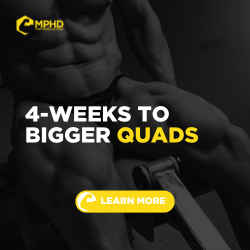Introduction
Welcome to our series on Writing your own Program! This is the first installment of what should be (at least) 3-4 different articles. We’re going to split each section up to reduce the typographical footprint of the overall series as all of these combined would be quite the reading marathon.
Now, onto the nitty gritty. Unfortunately, these days you can get a BS, and even an MS, in exercise science (or a related field) and still have NO idea how to write a training program. I’ve seen this many times over when recruiting interns or potential employees; just about everyone is uncertain of how to write a training program for themselves, let alone someone else.
One main reason for this is quite simple – most college professors have no idea how to write a training program either. And when you find one that does know how, they also know that the answer to literally every programming question is, “it depends.” Therefore, they don’t spend too much time harping on program design.
Is it possible to learn how to design programs without college? Sure, but you’re going to have to read a lot of articles like the ones in this series. You’re going to have to pick the brain of anyone and everyone you meet. And, last but certainly not least, you’re going to have to experiment on yourself. A lot. Heck, you should even consider offering to train some friends or family FOR FREE just to gain more insight into how to write training programs. I’ve trained more people for free (or extremely cheap) than I can count, and I don’t regret that one bit. Designing training programs can (and should) be incredibly simple, but you’ll have to put in a good chunk of work to understand the nuance to the ever present, “it depends.” Which, in turn, complicates the process just a bit.
So, without further ado, let’s get started with Part 1 of the series.
Where to Start?
 When designing a training program, where do you start? Do you just begin creating workouts and hoping for the best? Try a few different methodologies and see what happens? While that cavalier attitude sounds like fun, you’d be skipping what could be the most important component of a training program.
When designing a training program, where do you start? Do you just begin creating workouts and hoping for the best? Try a few different methodologies and see what happens? While that cavalier attitude sounds like fun, you’d be skipping what could be the most important component of a training program.
Why are you training? What are your top 2-3 training goals?
Your answer to these questions should direct virtually everything you put in your training program. If you don’t know WHY you’re doing an exercise, why is it in your program? If you don’t know what your goals are, HOW could you design individual workouts to support your goals? Before you type a single letter in that sample training template you found on Google, identify your top three goals using the SMART system:
Specific: Don’t throw out the random goal of “I want to gain muscle.” How much muscle do you want to gain? Specify that in your goal.
Measurable: Outline goals that can be measured. 1RM’s in certain lifts, changes in body fat, muscle mass, weight, limb girth, etc. can all be measured pretty reliably with the right system in place. Some people hire a coach to improve their running technique – how are you measuring your improvement in your journey to this goal? Make sure you know how to measure your progress when setting a goal.
Attainable: How often have you heard someone say they want to gain, say, 25lbs of muscle in the next two months? Is that even possible? Well, unless you’re a giant radioactive lizard, probably not. Certainly, freaks exist and could absolutely accomplish that feat. However, since most of us fall under the umbrella of 99.99999% of the population, that’s not an attainable goal. How about, say, 5-lbs of muscle in 3-months? Difficult, yes. But also attainable under the right conditions.
Relevant: This one isn’t as applicable to fitness goals as it is to business goals, etc. but it’s still important to remember your overall context of training. When you set your ultimate goal, you’re also going to set small feeder goals that are designed to lead you to your ultimate goal. These small goals (e.g., workout 4 times this week) are what allow you to reach your larger goals, and they definitely need to be relevant to whatever that larger goal is. If you’re trying to get jacked, setting a goal on how many seashells you can collect isn’t particularly helpful for your overall goal.
Timely: This is likely the largest component that many people screw up – give yourself a timeline! Don’t just say, “I want to gain 5-lbs of muscle.” That’s way too open ended and, for all intents and purposes, leaves the option of never completing your goal. Give yourself a strict timeframe to motivate yourself to stick to your goal. This directly links up with the “Attainable” step to ensure goals are attainable in a given time frame.
So, our “I want to gain muscle” goal has now turned into “I want to gain 5-lbs of muscle in the next 3-months and I plan on using my gym’s InBody system to measure my progress.” That’s a great goal – now we can start to design your training program.
How to Start?
 Now that you’re geared up and ready to train for your new goal, what do you do? Write up a quick program and head to the gym? Not quite, buckaroo. Before you really get into the nitty gritty of the details of your program, you need to make a self-assessment. In short, what do you suck at? What could you be better at? And, lastly, what are you pretty good at?
Now that you’re geared up and ready to train for your new goal, what do you do? Write up a quick program and head to the gym? Not quite, buckaroo. Before you really get into the nitty gritty of the details of your program, you need to make a self-assessment. In short, what do you suck at? What could you be better at? And, lastly, what are you pretty good at?
This moment of self-reflection will offer a lot of clues for how to direct various pieces of your training program. If you’ve trained others before, you know how important it is to assess each client from multiple standpoints. While each coach or trainer has their own assessment system, what should you use for yourself? Well, it depends. Dagnabbit, we’re already running into that answer.
How long have you been training? If you’ve been at it for less than year, it’s really worth the money to get an assessment from a qualified professional. Many people don’t have the dough to hire a personal trainer full time and that’s perfectly fine. But it’s absolutely worth it to get a professional opinion of what you need to work on the most – especially if you have huge long-term goals. You’ll need to stay healthy to reach those goals and working on your weaknesses is incredibly important for staying healthy.
If you’ve been under the bar consistently for over a year, you might have a fairly decent idea of where you’re at in the gym. You might know that your squat form needs some work, or maybe your biceps could use some extra size. At this point in most people’s training careers, they’re noticing what they need to focus on more to reach their ideal physique or strength goals.
Take some time self-assessing. Film yourself in the gym if needed. Get a written report of your professional assessment if you go that route. All of these pieces will start to fill in your puzzle of how you need to train to achieve your goals. For instance, if you’re wanting to add 25-lbs to your squat max in the next 3-months, film yourself squatting decently heavy and see where your form starts to break down. Now, add in accessory exercises to build that deficiency. Remember, a chain is only as strong as its weakest link, so diminishing any weak links you might have is incredibly important to getting stronger.
What if your long-term goal is to grace the bodybuilding stage? This is also an opportunity to get a slightly different assessment with either a bodybuilding coach or judge. These folks can let you know what muscle groups or areas you need to focus on the most to bring your best package to the stage. Now you know where to spend a good portion of your training efforts. If you don’t feel like shelling out the cheese for such an assessment, get good at taking progress pictures and be as critical as you can allow yourself to be each time you update. Find a clean mirror with decent lighting so you can truly see minute changes in your physique as you go along.
Conclusion
Don’t worry, there’s much more to talk about in the next few installments of this series. However, the steps in this piece are probably the most important when it comes to designing a training program. Much like setting a GPS in your car, you have to know where you’re going (goals) and where you’re starting (assessment) before you can figure out how to get to your end destination.
Think critically about your current training program – whether you’re winging it or are on a set program. Have you identified a SMART goal? Have you critically assessed your baseline starting point? If you haven’t taken either of these steps, what are you doing? Don’t spin your tires in the mud like many others at the gym – start assembling your training program puzzle!
From being a mediocre athlete, to professional powerlifter and strength coach, and now to researcher and writer, Charlie combines education and experience in the effort to help Bridge the Gap Between Science and Application. Charlie performs double duty by being the Content Manager for The Muscle PhD as well as the Director of Human Performance at the Applied Science and Performance Institute in Tampa, FL. To appease the nerds, Charlie is a PhD candidate in Human Performance with a master’s degree in Kinesiology and a bachelor’s degree in Exercise Science. For more alphabet soup, Charlie is also a Certified Strength and Conditioning Specialist (CSCS), an ACSM-certified Exercise Physiologist (ACSM-EP), and a USA Weightlifting-certified performance coach (USAW).




